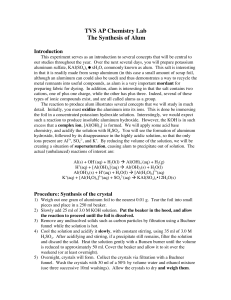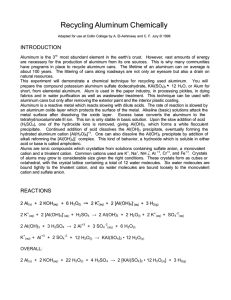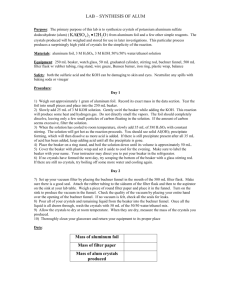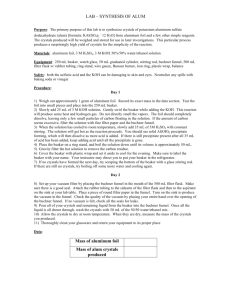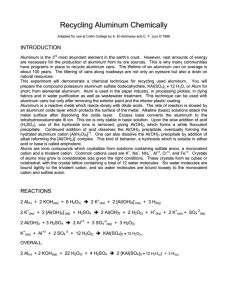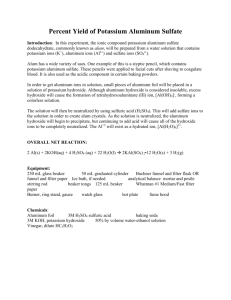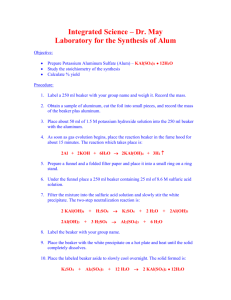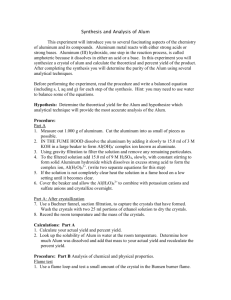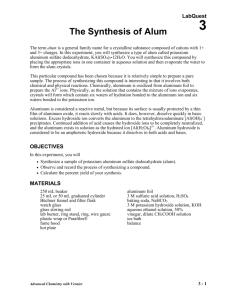Aluminum to Alum
advertisement
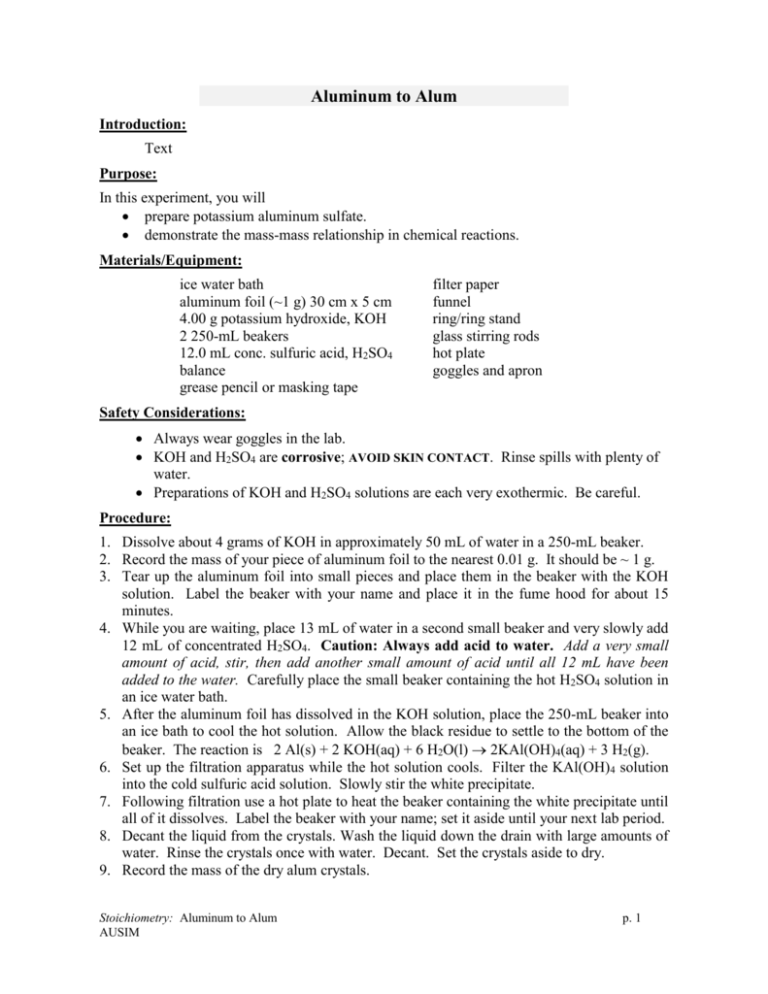
Aluminum to Alum Introduction: Text Purpose: In this experiment, you will prepare potassium aluminum sulfate. demonstrate the mass-mass relationship in chemical reactions. Materials/Equipment: ice water bath aluminum foil (~1 g) 30 cm x 5 cm 4.00 g potassium hydroxide, KOH 2 250-mL beakers 12.0 mL conc. sulfuric acid, H2SO4 balance grease pencil or masking tape filter paper funnel ring/ring stand glass stirring rods hot plate goggles and apron Safety Considerations: Always wear goggles in the lab. KOH and H2SO4 are corrosive; AVOID SKIN CONTACT. Rinse spills with plenty of water. Preparations of KOH and H2SO4 solutions are each very exothermic. Be careful. Procedure: 1. Dissolve about 4 grams of KOH in approximately 50 mL of water in a 250-mL beaker. 2. Record the mass of your piece of aluminum foil to the nearest 0.01 g. It should be ~ 1 g. 3. Tear up the aluminum foil into small pieces and place them in the beaker with the KOH solution. Label the beaker with your name and place it in the fume hood for about 15 minutes. 4. While you are waiting, place 13 mL of water in a second small beaker and very slowly add 12 mL of concentrated H2SO4. Caution: Always add acid to water. Add a very small amount of acid, stir, then add another small amount of acid until all 12 mL have been added to the water. Carefully place the small beaker containing the hot H2SO4 solution in an ice water bath. 5. After the aluminum foil has dissolved in the KOH solution, place the 250-mL beaker into an ice bath to cool the hot solution. Allow the black residue to settle to the bottom of the beaker. The reaction is 2 Al(s) + 2 KOH(aq) + 6 H2O(l) 2KAl(OH)4(aq) + 3 H2(g). 6. Set up the filtration apparatus while the hot solution cools. Filter the KAl(OH)4 solution into the cold sulfuric acid solution. Slowly stir the white precipitate. 7. Following filtration use a hot plate to heat the beaker containing the white precipitate until all of it dissolves. Label the beaker with your name; set it aside until your next lab period. 8. Decant the liquid from the crystals. Wash the liquid down the drain with large amounts of water. Rinse the crystals once with water. Decant. Set the crystals aside to dry. 9. Record the mass of the dry alum crystals. Stoichiometry: Aluminum to Alum AUSIM p. 1 Name _________________________ Partner’s Name(s) _________________________ Period ______Date_______________ Aluminum to Alum Data: Mass of aluminum foil: Mass of alum crystals: . Questions: 1. The formula for alum is KAl(SO4)2; what is its molar mass? 2. How many moles of alum were produced? 3. How many moles of aluminum foil were consumed? 4. One mole of aluminum should produce one mole of alum. Calculate the expected yield of alum in grams based on the mass of aluminum you used. 5. Calculate your percent yield. 6. Discuss potential sources of error including how each would affect your results. Stoichiometry: Aluminum to Alum AUSIM p. 2 Teacher Notes Aluminum to Alum Lab Time: # minutes Preparation: TIME: # minutes T: Set up V: Will provide Considerations: Both KOH and H2SO4 solutions are corrosive. Solution formation is quite exothermic for both of them. Extreme caution should be observed when handling these substances. Answers to Questions: 1. Copy questions. Answers in italics. Stoichiometry: Aluminum to Alum AUSIM p. 3
